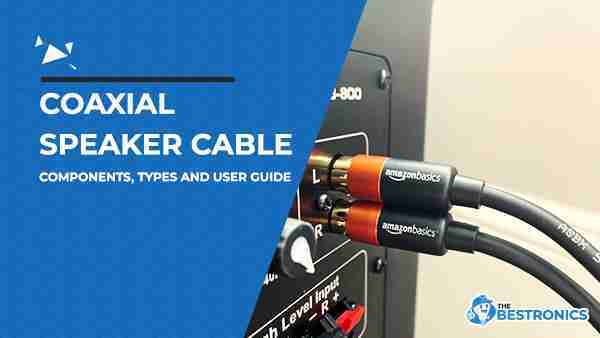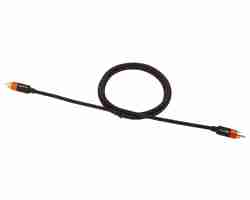Coaxial speaker cable, commonly known as coax, is widely used wire by internet and telecommunication companies because it transfers premium quality video and audio data. With high-speed communication, it was required to have a premium transportation medium that could provide better services than the ones available in the early 20th century.
As a result of its dependable, accurate transmission, coaxial audio cable became a go-to solution. The success of coax lies behind its shielded design.
What Is A Coaxial Speaker Cable?
A coax for audio is a type of electrical cable that transfers RF signals from any device from a source to the destination device. These wires are commonly utilized in professional audio systems, which provide consistent and quality sound. Moreover, their radiofrequency range varies from 20 kHz to 300 GHz.

Despite being similar to RCA cable, there is an essential difference in that Coax can transmit digital signals. Therefore, the listener can receive a higher bandwidth, ensuring a reliable connection. Their structure and exterior are strong and durable.
These cables are compatible with a wide variety of speakers and subwoofers, which have a length between 75 cm and 6 m. Moreover, specially designed cables for subwoofers offer high-quality audio with a secure connection.
Components Of Coaxial Cable
There are 4 components in a coaxial cable.
- Shield or outer conductor
- The jacket protects the internal parts of the cable. It is an exterior layer of polymer
- Dielectric, which separates external and internal conductors
- Center conductor or inner conductor

Amazon Basics Digital Audio Coaxial Cable
The 4-foot-long coax cable is a highly compatible and convenient product. It can work with a variety of devices. Moreover, its gold-plated connectors make it resistant to corrosion. A durable and user-friendly design makes it an ideal option.
Pros Of Digital Coaxial Audio Cable
- Durable
- Reduce signal loss
- In short-distance transmission, you get reliable performance
- Insensitive to noise or interference
- Improved tensile strength
- Wide bandwidth transmission of signals
- Better flexibility
- User-friendly
- Ideal for professional use
- Excellent sound quality
- Affordable
Cons Of Digital Coaxial Audio Cable
- Signal loss in long-distance transmission
- Bulky
- At connection, the signal may leak
- Due to thickness and stiffness, long-distance installation is expensive
- Fluctuations in speed during high usability
- Running and concealing cable can be time-consuming
Types Of Coax Cables
The common types of coaxial cable are the following.
Construction Based
There are 5 types of cables based on their construction.
- Flexible Coax: It has a fine wire braided exterior which offers better flexibility. There is less comprehensive shielding which signals a leak.
- Semirigid Coax: It has a tubular and durable metallic exterior like a pipe. Thus, it has uniform impedance with excellent shielding.
- Triaxial Coax: The cable comes with 2 exterior conductors separated by a dielectric layer. Besides that, it offers better noise immunity and shielding.
- Dual Coax: Shades exterior jacket encloses two separate coaxial speaker cables.
- Twinaxial Cable: It has an insulated conductor covered in the exterior conductor, which provides high-speed multiplexed transmission. Therefore, it is ideal for huge computer systems.
Impedance Based
There are 2 types of cables based on impedance.
- 50 Ohms: It is used for radio transmission because it is compatible with transmitters of various antennas. Besides that, they are used for high-frequency digital transmission.
- 70 Ohms: Commonly used for telecommunication and video or audio transmission in homes.
Radio Guide Standard Based
The RG standard will provide you following information about the cables.
- Shielding
- Outer diameter
- Impedance
- Core wire diameter
- Diameter and dielectric type
Quick Comparison Of Coaxial Speaker Cable Types
| Type | Impedance (Ohm) | Outer Diameter (mm) | Core Diameter (mm) | Function |
| RG – 6/U | 75 | 6.86 | 1.024 | TV, modems, and satellite TV |
| RG – 6/UQ | 75 | 7.57 | 1.024 | Cable and satellite TV, modems with stronger shielding. |
| RG – 7 | 75 | 8.13 | 1.3 | TV and modems |
| RG – 8/X | 50 | 6.1 | 1.47 | Amateur radio |
| RG – 8/U | 50 | 10.3 | 2.17 | Amateur radio |
| RG – 11/U | 75 | 10.5 | 1.63 | Satellite and Cable TV, modems with reduced losses |
| RG – 58/U | 50 | 5 | 0.81 | Amateur radio, ethernet, and communication on the radio. |
| RG – 59/U | 75 | 6.1 | 0.64 | HD HD video signal transmission for short distances. |
| RG – 60/U | 50 | 10.8 | 1.024 | Cable TV and high-speed cable internet. |
Types Of Connectors for Coaxial Cables
A variety of coaxial cable connectors are available, making it easy to connect them with different devices. Moreover, these connectors have a unique design that helps maintain shielding. Besides that, you will get a durable and reliable connection. Here are some common types available.
- BNC: Connect or disconnect radios, TV, test instruments, and more.
- TNC: They perform better microwave frequencies than BNC
- SMB: Provides extraordinary performance from DC to 4 GHz.
- QMA: Provides quick disconnection and locking convenience.
- 7/16 DIN: Ideal for high-wattage single transmissions. Good for antenna systems, defense applications, and cellular networks.
- RCA: Also known as cinch connectors which are ideal for TVs.
- MCX: Good applications with limited space, weight, or size.
Step By Step Guide To Using Coaxial Cable
Here is a simple step-by-step guide on how you can connect your coaxial speaker cable with various devices.
- Remove Old Connectors: Commonly cables available at home come with two connectors present at both ends. You have to remove them.
- Measure Length: The coax cable commonly available is 6 feet long. Thus, it is better to measure and know the exact length you will require.
- Remove Jacket: Before connecting the cable, you have to remove its insulating jacket. You can do it with a simple knife or a ringing tool.
- Unbraid Shield: Carefully unbraid shielding because you will need it for wiring your speakers. It may take some time, so you have to be patient.
- Remove Insulation: Remove the insulator to get the core wire inside it. After that, your connection will be done, and you can easily use your sound system.
Related: Speaker wire gauge chart
Bottom Line
Having a quality coaxial cable speaker will make it easier to connect various devices and enjoy using them. To ensure that you get the best quality cables and utilize them properly.
[acf field=”faq”]Coaxial Speaker Cable – FAQs
Q. Can I Use Regular RCA Cable For The Digital Coaxial Audio Connection?
A. Shape and size of RCA and coaxial with 75-ohm impedance, due to which you can easily use them interchangeably. For regular tasks, you can use an RCA cable instead of the coaxial audio cable.
Q. Can I Use a Subwoofer Cable For Digital Coaxial?
A. Yes, you can use digital coaxial for subwoofers over a long distance. They have a 75-ohm standard impedance, making them easy to interchange and getting similar quality performance.
Q. Is Coaxial Cable Preferable For Audio?
A. You will get high-quality audio with the Coax. Moreover, it is very easy to install and supports a higher bandwidth.
Q. Is It Possible To Use Coax As Speaker Cable?
A. You can use Coax as a special cable, but you may not get efficient results. However, you must substitute the F-connector through the RCA ends to make the system work perfectly. Moreover, connect powered subwoofers with it to utilize the speakers as you desire.
